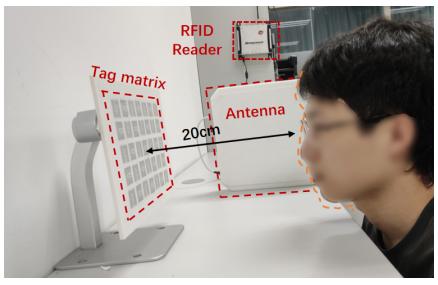News Face recognition system that does not use a camera, detects even in the dark just by shaking the face Developed by research teams in China and Australia
Image of RFID-based facial recognition system

"RFaceID: Towards RFID-based Facial Recognition" developed by a research team from Shenzhen University in China and the University of New South Wales in Australia is a facial recognition system that uses RFID technology. A user simply shakes his/her face in front of the RFID tag matrix for a few seconds to recognize the face. Since it does not use a camera, it can detect even in the dark. [Image] State of the experimentGenerally speaking, facial recognition requires visual input using a camera. However, common cameras such as PCs and smartphones do not have infrared lights for night vision, so accuracy decreases in poor lighting conditions. "There is also the risk of privacy leaks from cameras." Recently, it has also been found that attackers can easily obtain user facial information and extract relevant information (including 2D and 3D) for impersonation attacks. This time, we propose a face recognition system that uses RFID signals to solve all of these problems. RFID is a recognition technology that uses a reader to read IC tag information from a remote location without contact. It is commonly used for IC tickets such as ICOCA and Suica, and inventory management with tags attached to products. Using RFID technology, multipath reflections that differ from person to person (because each human face has a unique three-dimensional shape) are captured and classified. The hardware consists of an RFID reader, an RFID tag matrix, and an antenna. Collect facial data by asking each user to shake their head in front of the tag matrix for a few seconds. The RFID reader sends the collected facial data to a server, which authenticates the user's identity. In the system, we designed a neural network model that combines the spatial pattern recognition ability of CNN (Convolutional Neural Network) and the temporal pattern recognition ability of Bi-LSTM (Bi-Long Short Term Memory), and captures temporal characteristics. In addition, to effectively compensate for adverse effects such as environmental noise, face-shaking speed change, face-shaking direction change, and distance change, and to solve the problem of overfitting caused by small-scale training data, We also propose new data augmentation techniques to increase overall robustness. In the experiment, 100 subjects were evaluated and showed that RFaceID achieved a classification accuracy of 93.1%. Security analysis and user survey showed the practicality of the system. Source and Image Credits: Chengwen Luo, Zhongru Yang, Xingyu Feng, Jin Zhang, Hong Jia, Jianqiang Li, Jiawei Wu, and Wen Hu. 2022. RFaceID: Towards RFID-based Facial Recognition. Proc. ACM Interact. Mob. Technol. 5, 4, Article 170 (Dec 2021), 21 pages. DOI: https://doi.org/10.1145/3494985 * By Hiroki Yamashita, who presides over the web media "Seamless" that introduces the latest research in technology writing. Mr. Yamashita picks up highly novel scientific papers and explains them.
ITmedia NEWS
Last update: ITmedia NEWS